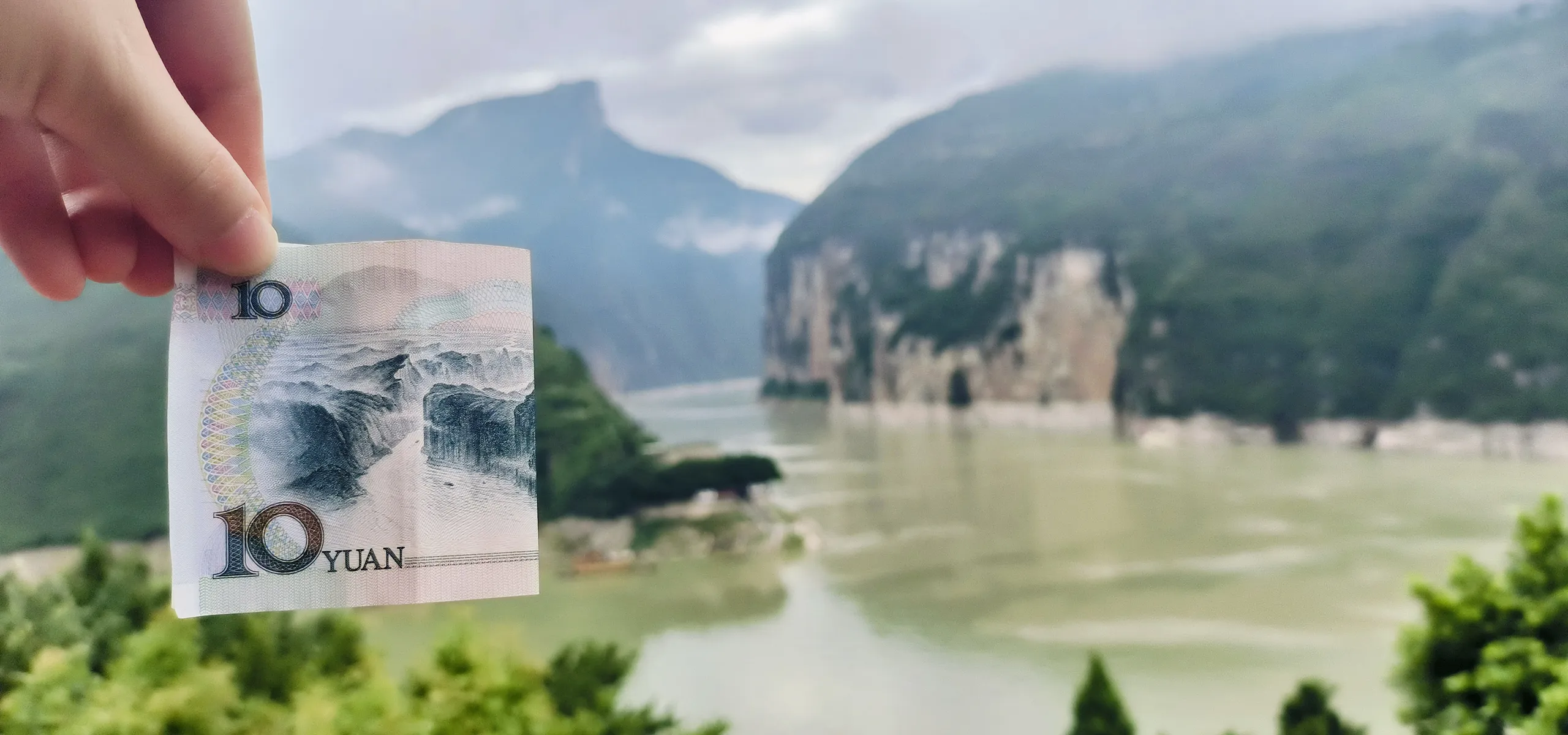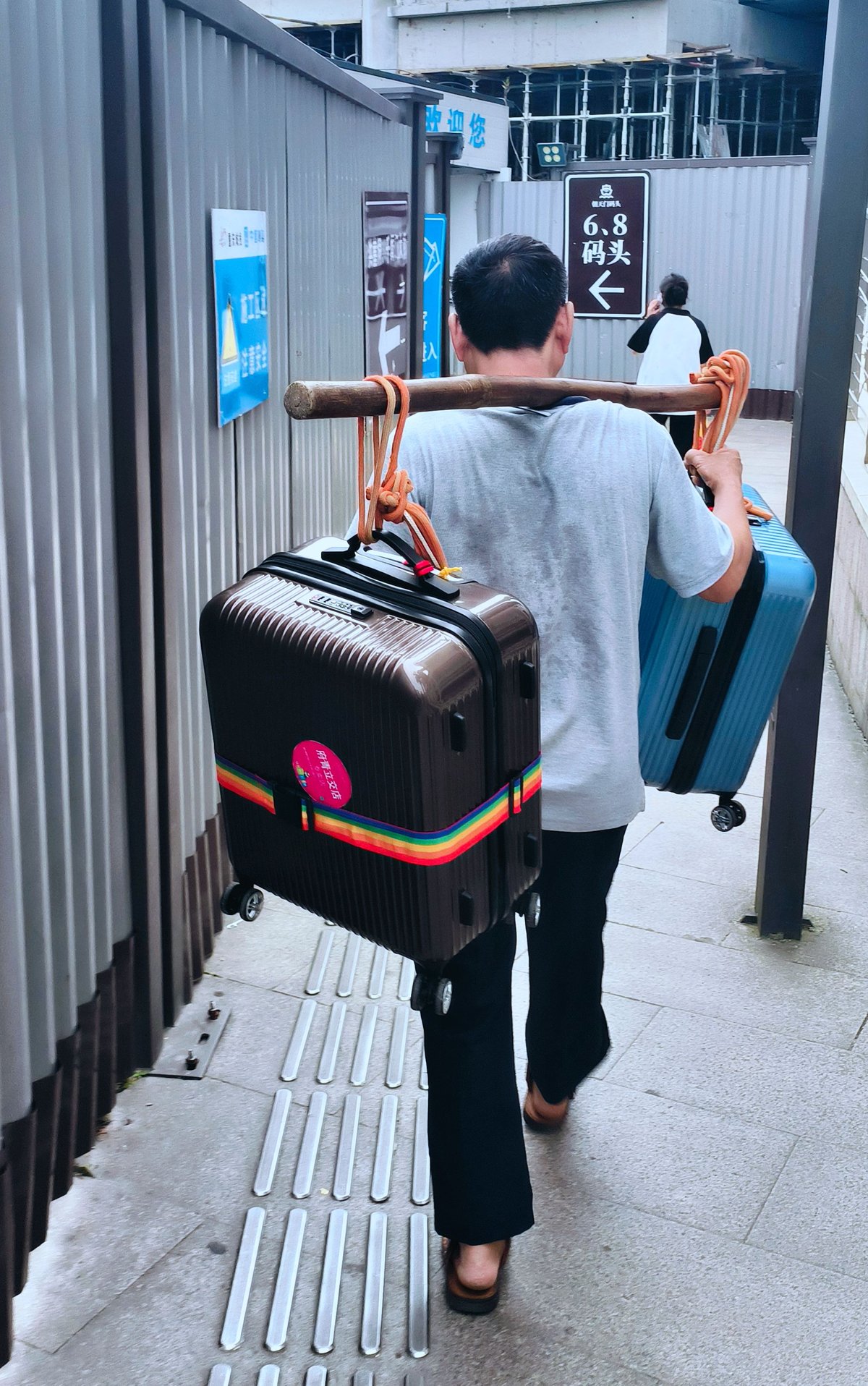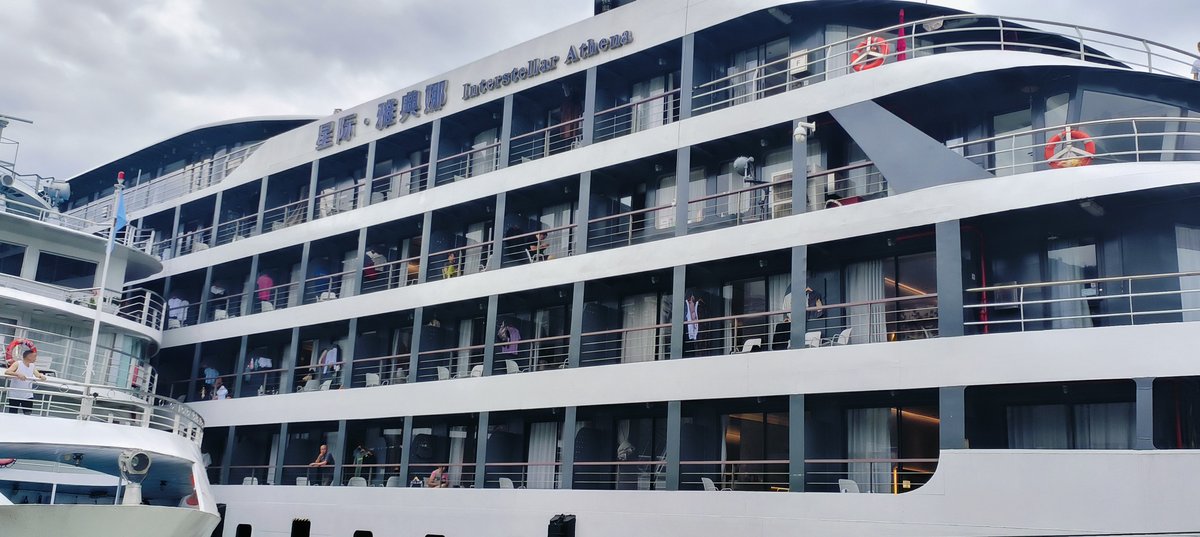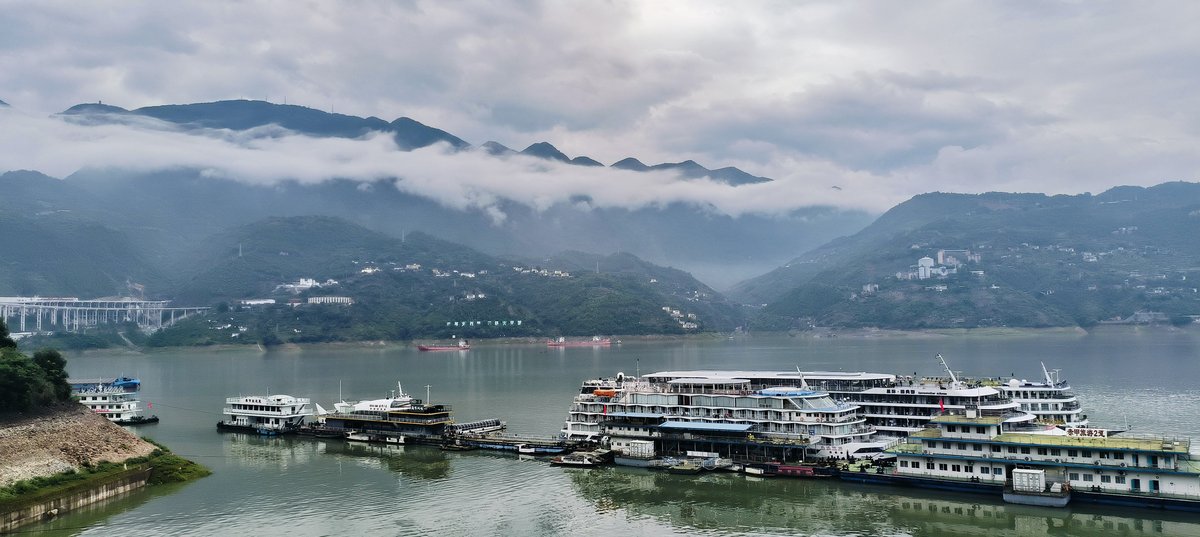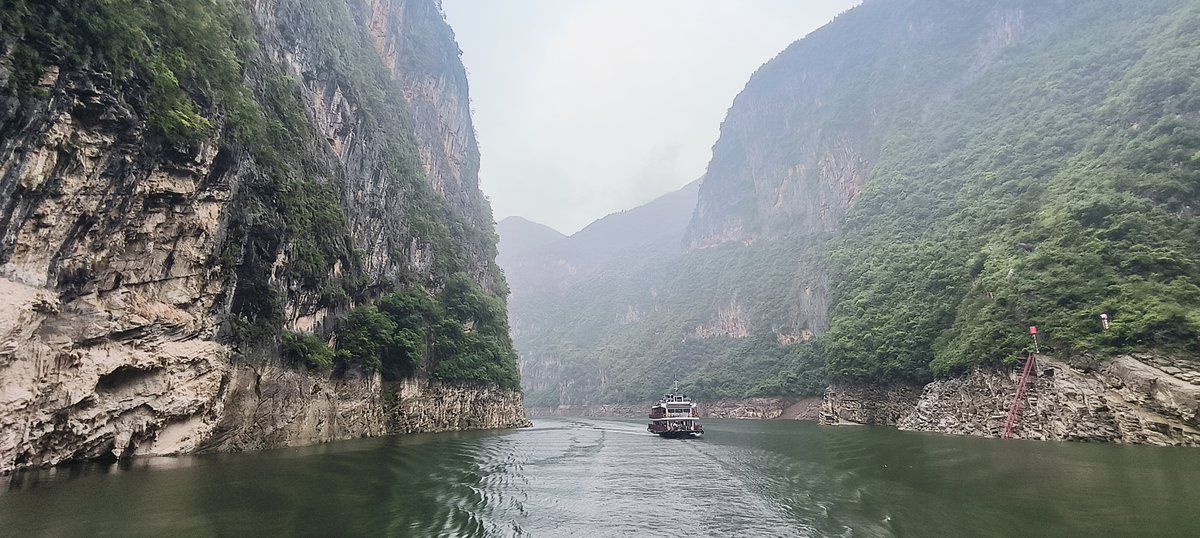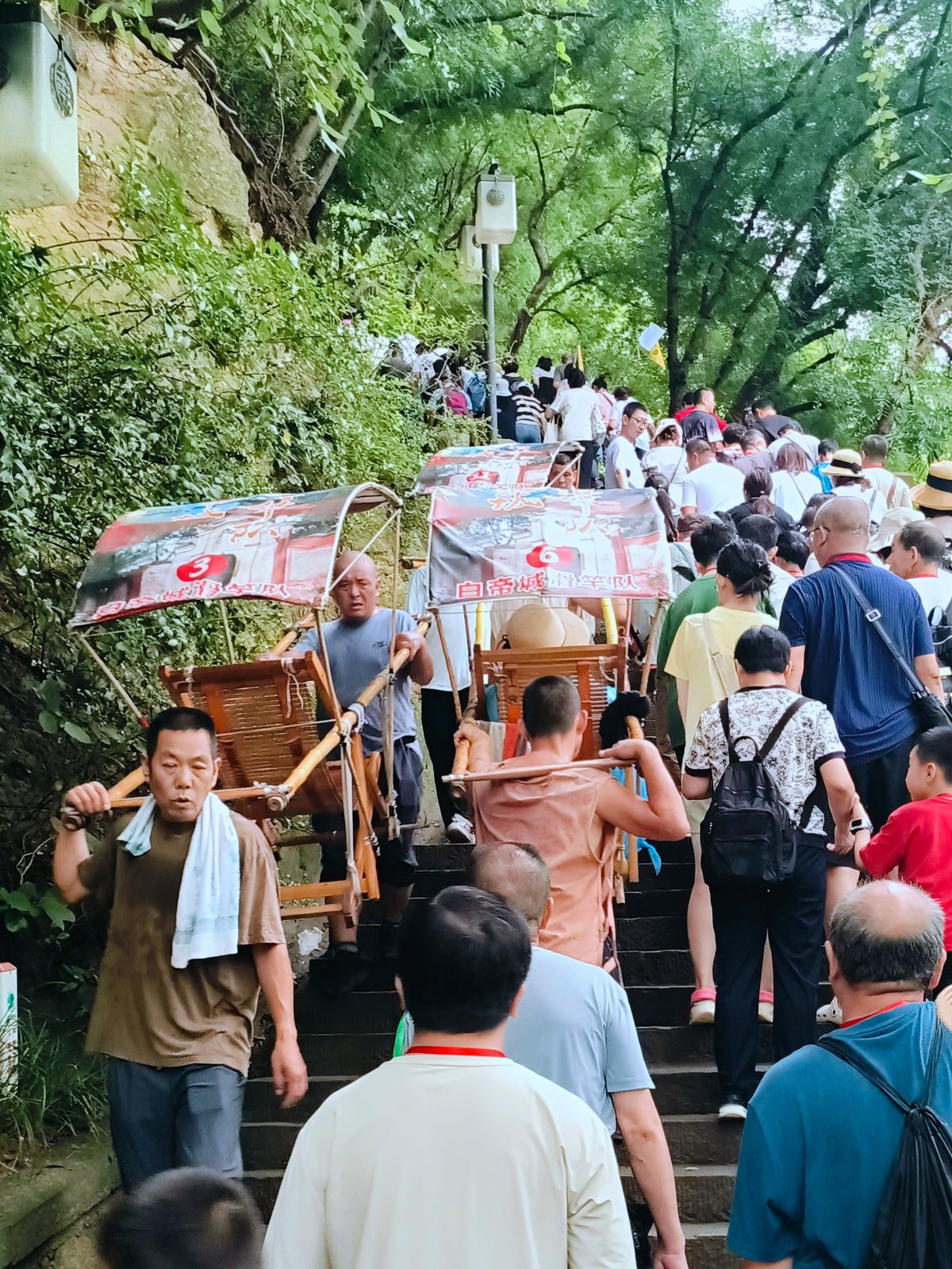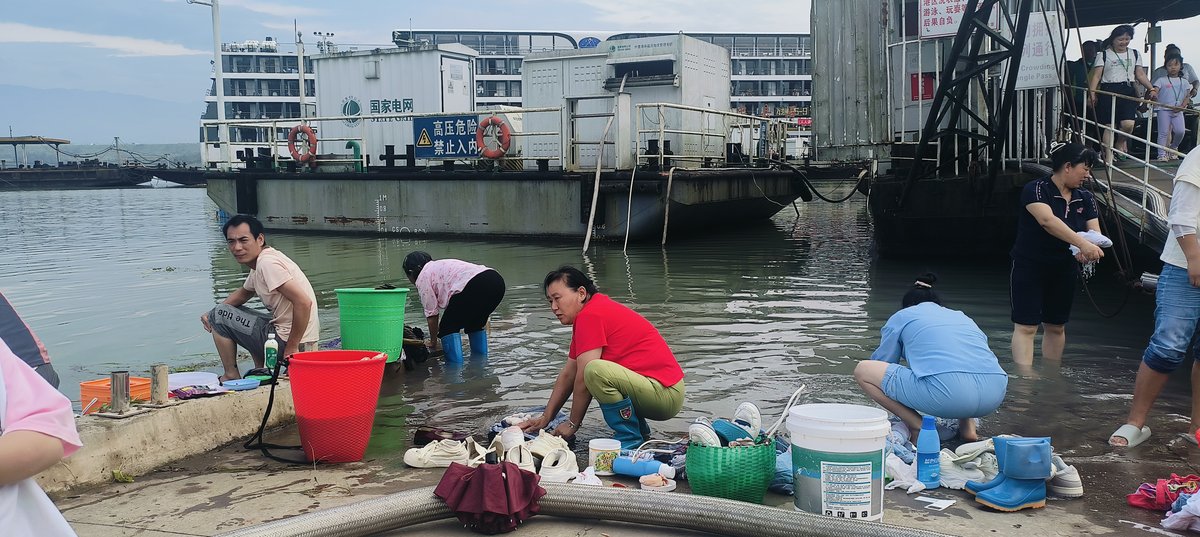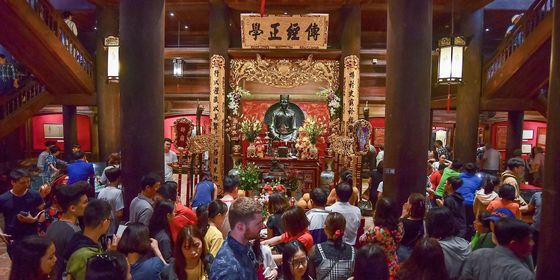What’s it like to board a ten-thousand-ton ship and embark on a 4-day, 3-night cruise down the Yangtze, China’s largest river?
When my family of six hopped off the subway at Chaotianmen Wharf, we found ourselves on the third floor of a shopping mall, instead of underground. This is the unique magic of Chongqing, a southwestern Chinese mega-city carved almost entirely into steep hills beside the Yangtze River.
From the subway stop, we faced the daunting task of dragging our luggage several stories down and crossing a busy road to reach the cruise terminal. However, we knew our cargo would be in good hands. “Want me to carry your luggage? 10 yuan apiece,” multiple middle-aged men asked us, holding wooden sticks in their hands. They are Chongqing’s renowned porters-for-hire, called bangbang (棒棒) or “stick stick men” after the shoulder poles they use to tote heavy wares.
Our porter is tall, dressed simply in a gray shirt, and looks much younger than his 60 years. With one of our suitcases tied to each end of his pole, he moved nimbly down six flights of spiral staircases and across a long trestle to the cruise ship. Back when the majority of China’s trade flowed via the Yangtze River, bangbang swarmed the steep stairs up and down the docks with their heavy burdens, making a living through sheer strength and willpower. But the future of this trade isn’t optimistic. Most bangbangs are around this man’s age, and they have no successors in sight. Add in the gradual improvement of transportation technologies, and it’s highly likely that they will soon be consigned to Chongqing’s history.
For now, though, our bangbang boasts to us about our ship—the Interstellar Athena. “Now that’s some high-end ship, owned by a foreign boss!” The foreign boss was a myth, but if the ship’s space-age name was any indication, then we were in for an out-of-this-world journey. At 120 meters long and 19 meters wide, the Interstellar Athena runs on electric energy and offers 210 guest rooms with ensuite balconies on six stories. She took her maiden voyage in 2021, and displaces 12,000 tons of water.
All aboard!
Choosing a cruise ship is not unlike finding a date. For a family trip with four grandparents and a child, I spent two months looking for a boat that was safe, comfortable, and reasonably priced. Over 50 cruise ships operate on the Yangtze with ticket fares ranging from 800 to 8,000 yuan, each touting all sorts of tempting perks: huge video game salons! 24-hour bar! Child-friendly!
On social media, cruise ships go above and beyond to attract new passengers. For instance, a ship called the Royal Splendor is designed like a Chinese palace and carries a claimed 9,999 dragon-themed objects on board. Passengers may slip into their dragon robes before sitting on their dragon thrones to experience a trip with imperial comfort. Another ship offers onboard math tutors for anxious parents keen to boost their kids’ grades in a distraction-free environment before the end of vacation.
Read more about traveling in China:
- The Nuclear Secret Under Chongqing’s Mountains
- The Famous Chinese County That No One Visits
- Wild Ride to Xanadu
The Yangtze has seen ships along its course for thousands of years, but today’s recreational cruise industry has only existed for the past 40 years. The first cruise ships, including the Bashan and the Emei, appeared on the river in the early 1980s, boasting open-air swimming pools. Five-star German-made luxury ships—the Princess Jeannie, Princess Sheena, and Princess Elaine—came on the scene in the mid-1990s. They still spanned no more than 130 meters, but were equipped with thrusters that enabled the ship to turn on the spot.
Still, at that time, a cruise was an unattainable fantasy to most Chinese. More accessible was James Cameron’s Titanic, which came to Chinese cinemas in 1998. It is estimated that one in five Chinese spectators watched the film more than once in theaters, and it shaped the perception of cruise ships as opulent, castle-like structures that are just one misstep away from disaster.
Admittedly, the Yangtze is not immune to such tragedies. In June 2015, the cruise ship Oriental Star encountered sudden winds near Jianli, Hubei province, and sank in a matter of minutes, taking the lives of 442 people on board. The rescue of the Oriental Star was broadcast live and the national audience despaired when news came that only 12 people survived. The accident dealt a huge blow to the confidence of a then-emerging Yangtze River cruise industry, and prompted local authorities to mandate stricter safety regulations. Now, cruise ships are required to stop sailing and dock at the nearest safe location as soon as they get a meteorological warning.
Today, tourists who wish to cruise the Yangtze River can choose to go either downstream—Chongqing to Yichang, Hubei province—or upstream on the reverse route. My parents chose the less popular downstream option, totaling four days and three nights (one day and one night less than the reverse journey), because they liked the sound of “going with the flow.” Personally, I was just assuaged by the Interstellar Athena ticket prices, which cost less than 3,000 yuan per person (with an additional fee of 200 yuan for foreign travelers).
Communal life on board
Our first night on board was lively. Passengers hailed from all over the world, and most families consisted of several generations traveling together. Children ran excitedly in and out of rooms with doors wide open, and a mélange of regional accents echoed in the corridor.
Our busy communal life on the ship started in earnest at 6:30 a.m. the next morning. We were woken up by gentle music and a female voice piped through the loudspeakers, which cordially invited “guests on the second and third floors to breakfast in the restaurant.” After we had eaten, the broadcast beckoned us again to disembark at 8 to visit the first attraction en route—Fengdu Ghost City, a large theme park dedicated to local folk beliefs about the afterlife.
As the official spokesperson for “Family No. 120,” I collected our disembarkation certificates at the service desk. I also had to ensure that all six of us wore them around our necks, as we would need them to get on and off the ship every time. Back in the restaurant, we had been lined up by family number and divided into small groups of up to 30 people led by a single tour guide. Each visit ashore followed the same protocol: get your certificate, form a group, wait, and follow said group. The whole process took about an hour, eliciting loud protests from a few children and elders. But overall, we were an orderly bunch.
At each stop of our cruise, we would often see seven or eight other ships moored alongside ours. Some lacked barrier-free access for passengers with mobility issues. For this reason, many elderly tourists opted out of on-shore tours. They would instead sit on the balcony or stroll on deck, and chat the day away with passengers on neighboring ships. My father-in-law, aged 72, was among them: He spent the whole morning on deck chatting across the railing to passengers on the Presidential No. 7 and the Victoria Anna. By lunchtime, they’d found out all about each other’s places of origin, itinerary, cabin type, and the price of each other’s meals, and my father-in-law became convinced that the Victoria Anna was better managed than the Interstellar Athena. Their restaurant allocated fixed seats for each passenger and the crew went cabin-by-cabin to rouse any late risers who missed the call for breakfast. I wasn’t keen on such militant management, so I silently congratulated myself for choosing the right ship.
The Three Gorges
From time immemorial, the ancient kingdom of Shu (蜀), encompassing most of today’s Sichuan province, was blessed with a unique landscape of high mountains and swift rivers. This also made for inconvenient transportation, and lots of hardships and adventures that bred great literature. This was evident in the city of Baidi, an ancient town at the gateway to Ancient Shu, which used to house a community of exiled literati whose poems and stories were passed down to later generations.
The Interstellar Athena offered us a view of Baidi right as we entered the Three Gorges, the three most bizarre, perilous, and scenic canyons in the Yangtze River. Composed of the Qutang, Wuxia, and Xiling Gorges, they have a combined length of about 193 kilometers and are featured on the back of the 10-yuan Chinese note. As early as the sixth century, the geographer Li Daoyuan (郦道元) described the Three Gorges as having: “layered crags and striking peaks that cover the sky and continue for miles,” with “wailing monkeys populating both shores.”; “Here, the water was turbulent,” Li wrote, and “one could sail 1,000 li downstream in one day, faster than the wind.”
The Xiling Gorge boasts the largest hydropower station in the world: none other than the world-renowned Three Gorges Dam, located in Yichang. Construction began in 1994 after four decades of planning, and it was completed in 2009. Everything about the project was herculean, including the resettlement of 1.3 million people living on the floodplain to new towns on higher ground or even other provinces. Besides wiping out entire communities, the dam forever changed the natural landscape of the Three Gorges. Though some historical sites were relocated, others were lost forever under the Yangtze’s currents.
Baidi City’s fate lay somewhere in between. Originally a peninsula surrounded by water on three sides, the strip of land connecting it to the mainland was completely submerged after the dam’s construction. The mountain peak in the middle of the city became an island in the river, atop which the remains of Baidi Temple are preserved as the sole remaining cultural relic.
Looking east from this area, you’re sure to spot a cliff standing in the river. This is the gateway to the Three Gorges of the Yangtze River, otherwise known as the Kuimen Gate—immortalized as the image on the back of 10 yuan notes. It’s a tradition for tourists to fish for one such note in their pockets and hold it out to compare with the real deal. Though the Three Gorges Dam raised the water level here by about 90 meters, the view is still breathtaking.
The ancient Fengjie Wharf suffered a grimmer fate and is now entirely submerged, even if every brick of the iconic Yidoumen Gate was moved to the new wharf and rebuilt as a landmark. The new Fengjie Wharf is docked with huge cruise ships that bless locals with a steady stream of tourists ready to stimulate the economy. Business from the wharf all the way to Baidi seems to mostly consist of sedan chairs and freshly squeezed orange juice. Tourists who opt for the former can sit in a bamboo chair (or alternatively, only put their luggage onto the chair) and be carried by pairs of locals up and down the mountain. Oranges are a local produce. Spending money here comes with the bonus of acquiring a 10 yuan note from the vendor for your Kuimen Gate photo-op—a necessary perk in the age of cashless payment.
Though the Wuxia Gorge no longer towers over the sky with the oppressive feeling of yore, we can still wonder at the capricious clouds and fog in the mountains. Ms. Xue, our dutiful announcer, made sure to introduce us to the scenery on both sides through the broadcast system. Eighth-century poet Li Bai (李白) had evoked the landscape of the Three Gorges in his famous poem “Early Departure from Baidi City (《早发白帝城》)”:
With monkeys’ sad adieus the riverbanks are loud;
My skiff has left ten thousand mountains far away.
Here, Ms. Xue explained that our behemoth cruise couldn’t possibly pass through the Three Gorges if it wasn’t for the dam. But the monkeys here are no longer rowdy: Like the waters, they’ve been masterfully tamed by the locals to attract tourists like us.
Downriver locals
At the Wuxia section of the trip, passengers on the cruise ship can switch to a small boat and go upstream along the Daning River, one of the tributaries of the Yangtze. This journey presents a unique landscape of its own, known as the Lesser Three Gorges, which consists of a chain of cliffs as well as the legacy of the “hanging coffins,” the mysterious funerary tradition of the ancient Ba people. Nobody quite knows why, or how, they transported the heavy boat-shaped coffins up those steep cliffs to stuff them into the rocky crevices more than 1,000 years ago.
Two mountaineers of the Tujia ethnicity skippered my boat. Like many locals in the area, they earn their living by entertaining travelers with stories about what the Three Gorges looked like before the dam, and singing folk songs in their native language. Tourists can show their appreciation by purchasing the myriad souvenirs sold for 30 yuan apiece on the boat.
The Three Gorges region is typically shrouded in clouds and mist all year round, but the sunlight favored us on the last days of our journey. We made use of this rare, precious event by hanging our hand-washed laundry on clotheslines pulled up on our balconies. Our clothes fluttered like colorful flags as the Interstellar Athena moved silently along the watercourse.
The next evening, we docked at Shibaozhai Wharf, where a crowd of local aunties had the same idea. They did their washing in the river itself, laying their clothes flat on stones and hammering on them with sticks—even stepping on them with their feet—to spread the soap onto every fiber. As they looked up at our mammoth of a ship, garnered with our “flags,” we waved back at them, and were momentarily united in our shared labor.
Nightlife on the Interstellar Athena was a little too lively for me. Every night, there was a busy agenda featuring safety briefings, welcome dinners, farewell receptions, and even pop concerts on the deck. After that, I usually had to remember to take the laundry inside in case of sudden downpours at night. My father-in-law, though, was thoroughly entertained. He had traveled by boat twice, once to Japan and once to South Korea, but here he was singing the praise of our Yangtze River cruise. “You just can’t get bored here. If you run out of conversation with the crew and passengers, you can chat with folks aboard other ships, or even on the shore.”
Our journey ended at the Three Gorges Dam. Here, all of us hopped off and onto a small boat that was packed onto an elevator and descended 113 meters onto the other side of the locks in eight minutes. As for the Interstellar Athena? This giant simply turned around in search of a new load of tourists to feed, entertain, and equip with disembarkation cards on the return journey through one of the most spectacular landscapes of China.
Photography by Chu Dandan
Cruising the Yangtze: Monkeys, Math Tutors, and Magnificent Views on the Way to the Three Gorges is a story from our issue, “Back to the Wild.” To read the entire issue, become a subscriber and receive the full magazine.





